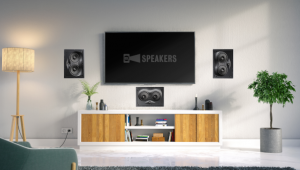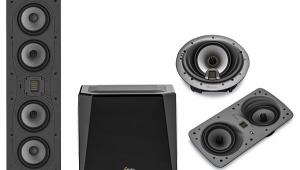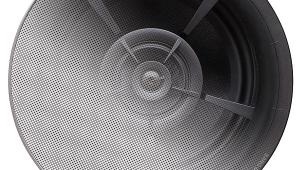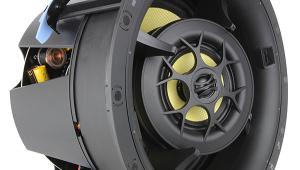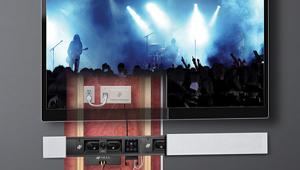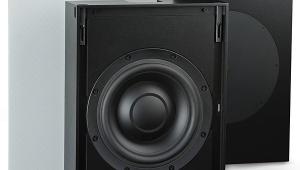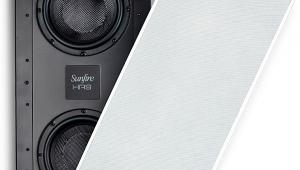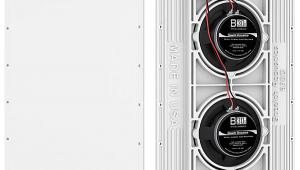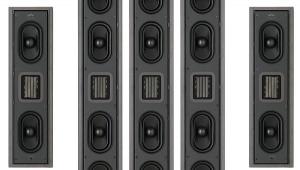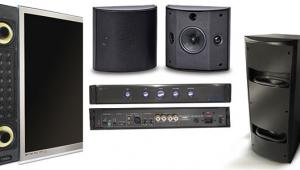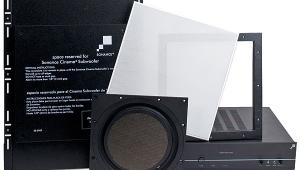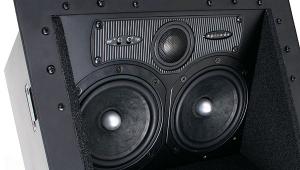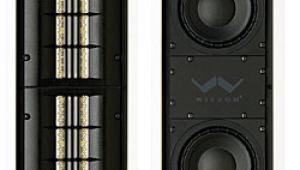Sheetrock 'n' Roll Page 2
 Triad InWall Gold/4 Omni
Triad InWall Gold/4 Omni
Triad's InWall Gold/4 Omni is another nontraditional in-wall speaker. Triad's approach involves placing a fully enclosed speaker in your wall. In addition to providing consistent sound performance no matter what type of wall you have in your home (brick, stucco, Sheetrock, old tires), the In-Wall Gold/4 Omni's sealed cabinet also minimizes the transfer of vibration to the wall behind the speaker. This is a nice feature if you're installing speakers in a wall that adjoins a bedroom or home office. Inside the cabinet are a 1-inch soft dome tweeter and a 6.5-inch woofer. Four metal legs that hold the InWall Gold/4 Omni in place slide out through side openings just behind the front of the cabinet. Thoughtfully, there are slots on both the sides and the top of the speaker, which allows for installation right up next to or under a stud. Once you get the cabinet in the wall, you screw the grille frame to the front of the speaker and snap the metal grille into place.

When it comes to sound, Triad is the best-kept secret in the custom-install business. As spoiled as I am after living with Legacy Audio's fabulous in-walls for several months, I was still surprised by these outrageously fine-sounding in-walls. The bass response was tremendous, in both quantity and quality, and they had no problem playing loud. The imaging was amazing, with a great sense of space and depth—not an easy task for an in-wall. Suzanne Vega's "Caramel" was simply spectacular, and Loreena McKennitt's "Dark Night of the Soul" was filled with delicate detail. In my opinion, you can't find a better all-around in-wall speaker for under $1,000 per pair. Three of these speakers across the front, matched with a pair of Triad's InCeiling Gold/6 Omni speakers (which use the same driver complement and cost $1,000 per pair) for the rear and one of Triad's in-wall subwoofers, would make for a truly invincible, invisible home theater.

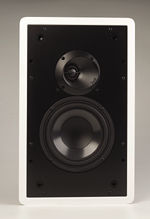 Snell AMC 760
Snell AMC 760
Evidently, no one told the folks at Snell that you can't do high-end in-walls. It's a good thing, too. The Snell AMC 760 is a two-way speaker in a fully enclosed aluminum cabinet. The same drivers that Snell uses in their freestanding speakers—in this case, a 1-inch aluminum dome tweeter and a 6.5-inch woofer—are mounted on a special multilayer, damped baffle. To direct the higher frequencies into the listening area, the AMC 760's Directed Power tweeter utilizes a wide-angle wave-guide with a fixed 20-degree angle. Although it's not as flexible as other systems that use pivoting tweeters, you can remove the wave-guide assembly and rotate it at 45-degree increments to aim the sound as needed. Unlike most in-wall speakers, the AMC 760 is available with either a fabric or a metal grille.
The one-piece AMC 760 mounts with the help of four dog-ear clamps that flare out to the sides. Evidently, the dog-ear system was designed with 0.5-inch-thick walls in mind because I couldn't get them to clamp down as tightly as they should have on my 0.375-inch walls. According to Snell, optional spacers are available for a 0.375-inch wall. In addition, unless I missed it somewhere, Snell doesn't include a cutout template with the AMC 760. (That's just downright rude.) Fortunately, you can hold the back of the speaker against the wall and trace a close approximation.
I stopped grumbling about installation issues once I began listening to these amazing in-walls. The presence of an enclosure makes a decidedly beneficial difference in the AMC 760's ability to reproduce subtle nuances and detail. These speakers definitely produced the most three-dimensional soundfield of the bunch, and they could easily fool you into believing that you were listening to a set of freestanding speakers if you had your eyes closed. Phase coherency was exceptional, so there was virtually no change in the sound's character when I moved from sitting to standing. As with most high-performance monitors of their size, however, while the AMC 760s produced tight, accurate bass, there wasn't an overabundance of it. These superb speakers deserve a high-performance sub to let them achieve their full potential, and the Atlantic Technology subwoofer system gave them exactly the foundation they needed.

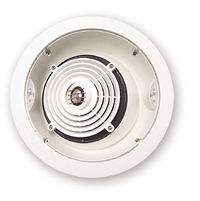 SpeakerCraft AIM Four
SpeakerCraft AIM Four
When SpeakerCraft introduced the aimable-speaker concept, with its eyeball-like pivot mechanism, my first thought was that it was just another marketing gimmick. In an AIM Series speaker, the woofer assembly is mounted inside what looks like the middle third of a sphere. This curved mount rests inside the main speaker bracket and can pivot about 45 degrees in any direction. Mounted in front of the woofer is SpeakerCraft's WavePlane, a series of concentric vanes that improve high-frequency dispersion. In the center of the WavePlane is an independently pivoting tweeter. In the case of the AIM Four in-ceiling speaker, a 1-inch aluminum dome tweeter is mounted in front of a 6.5-inch woven-glass-fiber cone woofer. You can easily access the three-position switches (–3 dB, 0, and +3 dB) for bass and treble on the front, and a metal grille covers everything after you've finished aiming and tweaking the speaker. The AIM Four is a one-piece design with four dog-ear clamps. At 5.5 inches deep, it'll fit in nearly any ceiling.

Gimmick or not, SpeakerCraft's AIM technology rocks. The speakers produced so much bass that, for a while, I thought I'd inadvertently hooked the subwoofers back into the system. The bass could be a little fat at times, especially with something as over the top as Lenny Kravitz's version of "American Woman." In general, though, I found the AIM Four to be an exceptionally accurate and especially easy speaker to listen to, soft or loud. The imaging was amazingly good, although it did take a little getting used to because it was located somewhat higher than ear level. For situations where the décor or construction won't allow an in-wall, this is a fantastic alternative for music and movies. It's almost scary to think how good a home theater with five AIM Fours would sound.

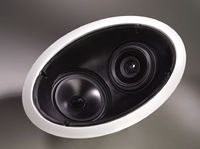 Sonance Ellipse 2.0 LCR
Sonance Ellipse 2.0 LCR
In a world of round and rectangular speakers, Sonance's Ellipse 2.0 LCR is elegantly different. A pivoting pod that contains a concentrically mounted 1-inch aluminum dome tweeter and a 4.5-inch aluminum cone midrange angles forward within the Ellipse 2.0 LCR's elliptical baffle. A 6.5-inch aluminum cone woofer angles to the rear but doesn't pivot. Once installed, the oval metal grille hides this unique design so that all you see is a nondescript elliptical grille that will blend into almost any ceiling.
The 5.9-inch-deep Ellipse 2.0 LCR is a one-piece design that uses Sonance's Flexbar mounting system. Since the Flexbars hold the speaker in place from the moment you slip them behind the Sheetrock, this makes installation above your head exceedingly easy.

If you've ever had any misgivings about the idea of an in-ceiling speaker, the Ellipse 2.0 LCR will put them to rest. In addition to having excellent bass response, these new Sonance in-ceiling speakers do a tremendous job of creating a believable soundstage in front of you (albeit at a little higher than ear level). Both male and female vocals were quite natural, and I'd describe these highly accurate speakers' sound as slightly laid-back, a nice aural match with their elegantly subdued aesthetic.

- Log in or register to post comments
